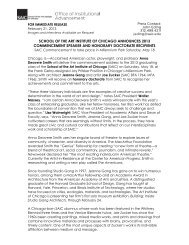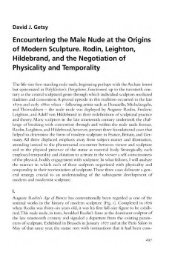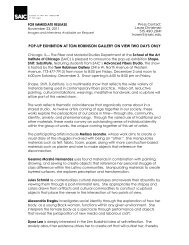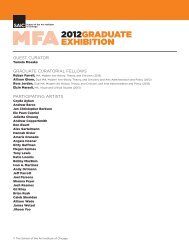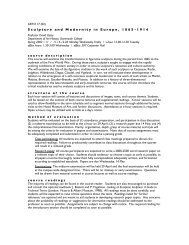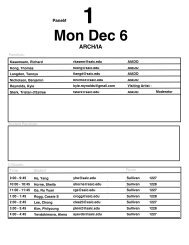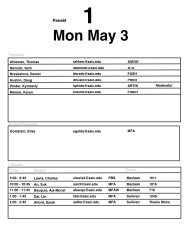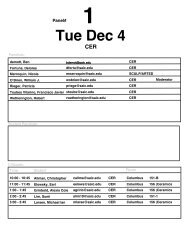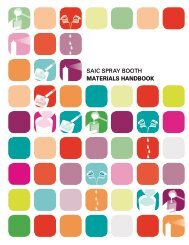i. institutional support and commitment to continuous improvement
i. institutional support and commitment to continuous improvement
i. institutional support and commitment to continuous improvement
You also want an ePaper? Increase the reach of your titles
YUMPU automatically turns print PDFs into web optimized ePapers that Google loves.
School of the Art Institute of Chicago<br />
Department of Architecture, Interior Architecture, <strong>and</strong> Designed Objects<br />
Master of Architecture<br />
Master of Architecture with emphasis in Interior Architecture<br />
diagram as Jones considered how artists think creatively.<br />
o “The Modern Art Institute”—December 7, 2010<br />
James Cuno, President <strong>and</strong> Eloise W. Martin Direc<strong>to</strong>r, The Art Institute of Chicago<br />
What does it mean <strong>to</strong> be modern now? With the recent opening of the Renzo Piano<br />
Modern Wing at the Art Institute of Chicago, President <strong>and</strong> Direc<strong>to</strong>r Cuno shared his<br />
views of modernism <strong>and</strong> the museum’s latest transformations.<br />
o “Non-Miesian Modernity <strong>and</strong> Messy Modern”—December 14, 2010<br />
Ben Nicholson, SAIC Associate Professor, Architecture<br />
Jacquelynn Baas, independent scholar <strong>and</strong> Direc<strong>to</strong>r Emeritus, Berkeley Art Museum<br />
This conversation departed from the established canon <strong>to</strong> consider alternate “non-Miesian”<br />
<strong>and</strong> “messy” narratives of modernism, suggesting how shifts of his<strong>to</strong>rical perspective change<br />
our perception of key his<strong>to</strong>ric works <strong>and</strong> those on view in<br />
“Learning Modern.”<br />
I. INSTITUTIONAL SUPPORT AND COMMITMENT TO<br />
CONTINUOUS IMPROVEMENT<br />
I.2. RESOURCES<br />
I.2.2 Administrative Structure <strong>and</strong> Governance<br />
AIC is a private, non-profit corporation whose unique characteristics are reflected in its administrative<br />
organization. Four officers comprise the corporate structure of the institution , including the Presi-<br />
dent of SAIC who acts as a Co-Chief Executive Officer with the President of AIC. Decisions regarding<br />
academic programs of SAIC flow up from various faculty committees; through the dean, provost, <strong>and</strong><br />
president; <strong>and</strong>, if appropriate, <strong>to</strong> the Board of Governors. Decisions regarding facilities <strong>and</strong> campus<br />
expansion ultimately result in decisions from the Board of Trustees following recommendation from<br />
the Buildings <strong>and</strong> Grounds Committee. SAIC, <strong>and</strong> AIADO within it, is administered through a series of<br />
administrative roles, which begin, from the <strong>to</strong>p of the hierarchy, with the trustees <strong>and</strong> governors, who<br />
approve hiring of executive office heads, including the president <strong>and</strong> provost of SAIC. Authority pro-<br />
gresses through the executive level <strong>to</strong> the deans, division heads, <strong>and</strong> academic units <strong>to</strong> the departmen-<br />
tal administration.<br />
Faculty contribute greatly <strong>to</strong> the management <strong>and</strong> governance of the School. All full-time faculty serve<br />
the School through elected positions or contractual committee service. Part-time faculty participate,<br />
<strong>to</strong>o, by electing representatives in faculty governance. Through these means of service, faculty at SAIC<br />
have vocal, influential, <strong>and</strong> decision-making participation in faculty compensation, hiring, <strong>and</strong> promo-<br />
tion; campus planning; executive searches; policy-setting, development initiatives; <strong>and</strong>, many other<br />
other governance decisions in addition <strong>to</strong> curricular development <strong>and</strong> teaching.<br />
Overviews of both the administrative <strong>and</strong> academic structure <strong>and</strong> governance of the School follow:<br />
A. ADMINISTRATIVE STRUCTURE<br />
An overview of the School’s administrative structure is described through a descending description of<br />
the major roles in the School’s administrative structure, ending with a detailed account of the adminis-<br />
trative structure of AIADO:<br />
1) Board of Trustees<br />
Architecture Program Report | 80



